Emerson whips up Core-based boards
Feb 1, 2010 — by LinuxDevices Staff — from the LinuxDevices Archive — 3 viewsEmerson Network Power has joined the many companies basing devices on Intel's new, embedded-oriented Core processors. Newly announced products include the company's COMX-CORE COM Express Module, the MATXM-CORE-411-B 9.6 x 9.6-inch microATX motherboard, and the iVM7210 VMEbus processor board.
Intel announced embedded-specific, 32nm Core i3, i5, and i7 processors earlier this month, along with the QM57 Express and Q57 Express chipsets. According to the chipmaker, advantages of the new parts include "Turbo Boost" technology that varies clock speed upon demand, integrated graphics cores adequate for "mainstream and casual gaming," plus advanced power-saving that can selectively shut down CPU cores.
Advantech, Avalue, Congatec, Eurotech, Ibase, IEI, and Kontron have already announced devices — listed in the links at the end of this story — based on the new Core CPUs. Now, Emerson Network Power joins them, launching a COM Express Module, a microATX (µATX) motherboard, and a VMEbus processor board. All these product use the QM57 Express chipset, and they support either Core i5 or Core i7 CPUs, according to the company.
COM Express module
Emerson Network Power's COM Express module supports dual-core Core i7 processors clocked up to 2.0GHz, or dual-core Core i5 CPUs clocked up to 2.4GHz. As usual for this 4.9 x 3.75-inch format, there are no external connectors, all signals instead passing through the COM Express connectors — seen at the bottom of the right-hand image, below — to an optional carrier board.
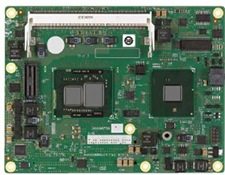
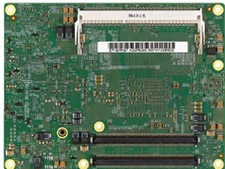
The front (left) and back (right) of Emerson's COMX-CORE module
According to Emerson, the COMX-CORE module does not employ COM Express Type 2 pinouts, which are the ones usually found. Instead, the company claims, it is a Type 6 module, dropping certain legacy I/O, adding "improved display support," and "future-proofing the USB interfaces for the upcoming USB 3 standard."
Emerson says Type 6 is defined by the PCI Industrial Computer Manufacturers Group (PICMG) COM.0 R2.0 standard, which is still "under development," according to the latter's website. Apart from its COM Express connectors, the COMX-CORE module has a USB connector, so that an optional flash disk (up to 16GB in size) may be connected to it directly, the company adds.
The COMX-CORE has two SODIMM sockets, one on either side, which support up to 8GB of DDR3 memory, Emerson says. Bus expansion is said to include seven PCI Express x1 and one PCI Express x16 interfaces. I/O, meanwhile, amounts to gigabit Ethernet, four SATA ports, eight USB ports, LPC, SPI, and HD audio, according to the company.
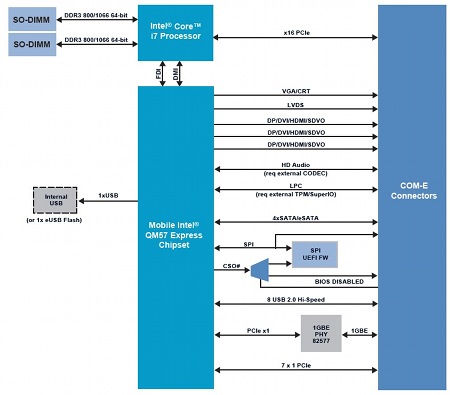
A block diagram of Emerson's COMX-CORE module
(Click to enlarge)
The COMX-CORE, a block diagram of which appears above, supports the Fedora Core 11 variant of Linux, as well as Windows XP, Windows Vista, and Windows Embedded for Point of Sale Systems, according to Emerson. Dual displays are possible without adding a graphics card, says the company.
microATX (µATX) motherboard
Emerson Network Power's MATXM-CORE-411-B (below) uses the 9.6 x 9.6-inch microATX (µATX) format, which gives it room for one PCI Express x16 expansion slot, three PCI Express x1 slots, and a PCI Express Mini Card slot. The board supports Core i7 processors clocked up to 2.6GHz, and accepts 8GB of DDR3 RAM via two SODIMM sockets, according to the company.
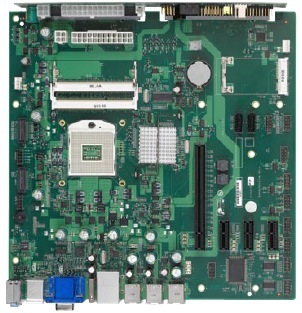
Emerson Network Power's MATXM-CORE-411B
According to Emerson, the MATXM-CORE-411-B is suitable for any microATX chassis, but comes with an optional "midplane" that helps with cable routing and holds some of its ports. The company says the device's coastline includes two standard USB 2.0 ports, plus two 12V PoweredUSB ports and one 24V PoweredUSB port. It's said the latter employs standard USB connectors combined with additional connectors that are keyed to carry 5V, 12V, or 24V supplemental power.
Other real-word ports cited by the company include an eSATA port, an RJ45 connector for gigabit Ethernet, PS/2 keyboard and mouse ports, VGA, HDMI, and 3.5mm jacks for microphone input, line output, and headphone output. Meanwhile, internal interfaces, noted on the block diagram below, include three SATA ports, two serial ports, LVDS, and eight additional USB ports.

A block diagram of Emerson's MATXM-CORE-411-B
(Click to enlarge)
According to Emerson Network Power, the MATXM-CORE-411-B supports SUSE Linux, as well as Windows Vista, Windows XP, and WEPOS.
VMEbus processor board
Emerson Network Power's iVME7210 is a VMEbus processor board designed for a range of industrial, medical and military/aerospace applications, including robotics, image processing, radar/sonar, and signal intelligence. The board supports 1.06GHz ULV or 2.0GHz LV Core i7 processors, includes 4GB or 8GB of soldered-down DDR3 memory, and has 256KB of non-volatile FeRAM (ferroelectric random access memory), the latter intended for critical data logging, the company says.
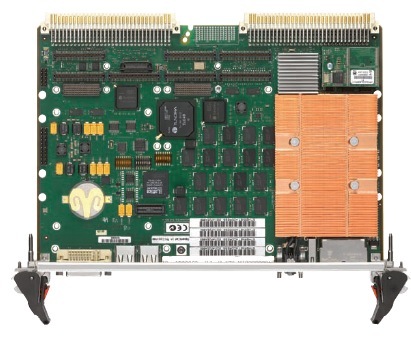
Emerson Network Power's iVME7210
Emerson says the iVME7210 (above) has front-panel interfaces that include a DVI-I output, three USB 2.0 ports, two RJ45 connectors for gigabit Ethernet, and a serial port. Rear interfaces include two additional gigabit Ethernet ports, four more serial ports, and up to two PMC/XMC sites, the company adds.

A block diagram of Emerson's iVME7210
(Click to enlarge)
According to Emerson, the iVME7210 has an operating range of 32 to 151 deg. F (0 to 55 deg. C), and will be available in additional extended-temperature and rugged versions in the future. Operating system support includes two Linux distributions — Fedora 11 and Red Hat 6 - as well as Wind River VxWorks and LynuxWorks LynxOS, according to the company.
Availability
More information on the COMX-CORE COM Express module may be found on Emerson's website, here.
More information on the MATXM-CORE-411-B microATX board may be found on Emerson's website, here.
More information on the iVME7210 VMEbus processor board may be found on Emerson's website, here.
This article was originally published on LinuxDevices.com and has been donated to the open source community by QuinStreet Inc. Please visit LinuxToday.com for up-to-date news and articles about Linux and open source.